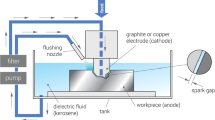Abstract
In this article, the effects of varying seven different machining parameters in addition to varying the material thickness on the machining responses such as material removal rate, kerf, and surface roughness of tungsten carbide samples machined by wire electrical discharge machining (WEDM) were investigated. The design of experiments was based on a Taguchi orthogonal design with 8 control factors with three levels each, requiring a set of 27 experiments that were repeated three times. ANOVA was carried out after obtaining the responses to determine the significant factors. The work piece thickness was expected to have a major effect on the material removal rate but showed to be significant in the case of surface roughness only. Finally, optimization of the machining responses was carried out and models for the material removal rate, kerf, and surface roughness were created. The models were validated through confirmation experiments that showed significant improvements in machining performance for all investigated machining outcomes.




Similar content being viewed by others
References
M.P. Groover, Fundamental of Modern Manufacturing: Materials, Processes, and Systems, 2nd ed, John Wiley & Sons, 2004
A.W.J. Hsue and H.C. Su, Removal Analysis of WEDM’s Tapering Process and Its Application to Generation of Precise Conjugate Surface, J. Mater. Process. Technol., 2004, 149(1–3), p 117–123
M.-T. Yan and P.-H. Huang, Accuracy Improvement of Wire-EDM by Real-Time Wire Tension Control, Int. J. Mach. Tools Manuf., 2004, 44(7–8), p 807–814
D. Rakwal and E. Bamberg, Slicing, Cleaning and Kerf Analysis of Germanium Wafers Machined by Wire Electrical Discharge Machining, J. Mater. Process. Technol., 2009, 209(8), p 3740–3751
M.P. Jahan, Y.S. Wong, and M. Rahman, A Study on the Fine-Finish Die-Sinking Micro-EDM of Tungsten Carbide Using Different Electrode Materials, J. Mater. Process. Technol., 2009, 209(8), p 3956–3967
M.P. Jahan, Y.S. Wong, and M. Rahman, A Study on the Quality Micro-Hole Machining of Tungsten Carbide by Micro-EDM Process Using Transistor and RC-type Pulse Generator, J. Mater. Process. Technol., 2009, 209(4), p 1706–1716
P. Saha, A. Singha, S.K. Pal, and P. Saha, Soft Computing Models Based Prediction of Cutting Speed and Surface Roughness in Wire Electro-Discharge Machining of Tungsten Carbide Cobalt Composite, Int. J. Adv. Manuf. Technol., 2008, 39(1–2), p 740–784
S.H. Lee and X. Li, Study of the Surface Integrity of the Machined Workpiece in the EDM of Tungsten Carbide, J. Mater. Process. Technol., 2003, 139, p 315–321
A.B. Puri, B. Bhattacharyya, and S.K. Sorkhel, Taguchi Method Based Experimental Studies for Controlled CNC Wire-EDM Operation Wire-EDM Operation, Proceedings of 19th All India Manufacturing Technology, Design and Research (AIMTDR) Conference, 2000, p 173–178
N. Tosun and C. Cogun, An Investigation on Wire Wear in WEDM, J. Mater. Process. Technol., 2003, 134(3), p 273–278
T.A. Lambert, Jr., and K.D. Murphy, Modal Convection and its Effect on the Stability of EDM Wires, Int. J. Mech. Sci., 2002, 44(1), p 207–216
S.M. Phadke, Quality Engineering Using Robust Design, 1st ed., Prentice Hall, Englewood Cliffs, New Jersey, 1989
Y.F. Luo, Energy-Distribution Strategy in Fast-Cutting Wire EDM, J. Mater. Process. Technol., 1995, 55(3–4), p 380–390
C.T. Lin, I.F. Chung, and S.Y. Huang, Improvement of Machining Accuracy by Fuzzy Logic at Corner Parts for Wire-EDM, Fuzzy Sets Syst., 2001, 122(3), p 499–511
N. Tosun, C. Cogun, and G. Tosun, A Study on Kerf and Material Removal Rate in Wire Electrical Discharge Machining Based on Taguchi Method, J. Mater. Process. Technol., 2004, 152(3), p 316–322
A. Bendell, J. Disney, and W.A. Pridmore, Taguchi Methods: Applications in World Industry, Springer, UK, 1989
Acknowledgments
The authors would like to thank the Department of Industrial and Manufacturing Engineering, University of Engineering & Technology Lahore, Higher Education Commission (HEC) of Pakistan and the Pakistan Navy for having made this research possible.
Author information
Authors and Affiliations
Corresponding author
Rights and permissions
About this article
Cite this article
Shah, A., Mufti, N.A., Rakwal, D. et al. Material Removal Rate, Kerf, and Surface Roughness of Tungsten Carbide Machined with Wire Electrical Discharge Machining. J. of Materi Eng and Perform 20, 71–76 (2011). https://doi.org/10.1007/s11665-010-9644-y
Received:
Published:
Issue Date:
DOI: https://doi.org/10.1007/s11665-010-9644-y




